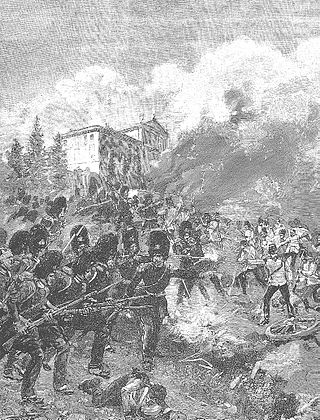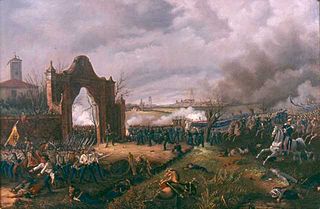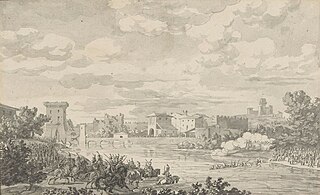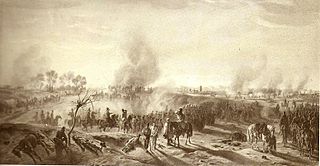
The Battle of Solferino on 24 June 1859 resulted in the victory of the allied French army under Napoleon III and the Piedmont-Sardinian army under Victor Emmanuel II against the Austrian army under Emperor Franz Joseph I. It was the last major battle in world history where all the armies were under the personal command of their monarchs. Perhaps 300,000 soldiers fought in the important battle, the largest since the Battle of Leipzig in 1813. There were about 130,000 Austrian troops and a combined total of 140,000 French and allied Piedmontese troops. After the battle, the Austrian emperor refrained from further direct command of the army.

Peschiera del Garda is a town and comune in the province of Verona, in Veneto, Italy. When Lombardy-Venetia was under Austrian rule, Peschiera was the northwest anchor of the four fortified towns constituting the Quadrilatero. The fortress is on an island in the river Mincio at its outlet from Lake Garda.

The First Battle of Custoza was fought on July 24 and 25, 1848, during the First Italian War of Independence between the armies of the Austrian Empire, commanded by Field Marshal Radetzky, and the Kingdom of Sardinia, led by King Charles Albert of Piedmont-Sardinia.

Goito is a comune with a population of 10,005 in the Province of Mantua in Lombardy. Goito is 20 kilometres (12 mi) north of Mantua on the road leading to Brescia and Lake Garda, and straddles the old east–west Via Postumia between Cremona and Verona. The town is on the right bank of the Mincio River at a key crossing. The birthplace of Sordello, Goito is part of the historic region known as Alto Mantovano and was the site of a notable fortress.

In the War of the Sixth Coalition, the Battle of the Mincio River was fought on 8 February 1814 and resulted in an inconclusive engagement between the French under Eugène de Beauharnais and the Austrians under Field Marshal Heinrich von Bellegarde. Fought on the same ground as Napoleon's victory at the Battle of Borghetto in 1796, the battle was not as decisive as Eugène hoped, and in the end it had little significant impact upon the war, whose outcome was to be decided in France rather than Italy.

The Battle of Castiglione saw the French Army of Italy under General Napoleon Bonaparte attack an army of the Habsburg monarchy led by Feldmarschall Dagobert Sigmund von Wurmser on 5 August 1796. The outnumbered Austrians were defeated and driven back along a line of hills to the river crossing at Borghetto, where they retired beyond the Mincio River. The town of Castiglione delle Stiviere is located 10 kilometres (6 mi) south of Lake Garda in northern Italy. This battle was one of four famous victories won by Bonaparte during the War of the First Coalition, part of the French Revolutionary Wars. The others were Bassano, Arcole, and Rivoli.

The First Italian War of Independence, part of the Italian Unification (Risorgimento), was fought by the Kingdom of Sardinia (Piedmont) and Italian volunteers against the Austrian Empire and other conservative states from 23 March 1848 to 22 August 1849 in the Italian Peninsula.

The Quadrilatero is the traditional name of a defensive system of the Austrian Empire in the Lombardy-Venetia region of Italy, which connected the fortresses of Peschiera, Mantua, Legnago and Verona between the Mincio, the Po, and the Adige Rivers. The name refers to the fact that on a map the fortresses appear to form the vertices of a quadrilateral. In the period between the end of the Napoleonic Wars and the Revolutions of 1848, they were the only fully modernized and armed fortresses within the Empire.

The Skirmish of Pastrengo was fought between the Piedmontese and Austrian army on 30 April 1848, in the course of the First Italian War of Independence.

The Republic of San Marco or the Venetian Republic was an Italian revolutionary state which existed for 17 months in 1848–1849. Based on the Venetian Lagoon, it extended into most of Venetia, or the Terraferma territory of the former Republic of Venice, suppressed 51 years earlier in the French Revolutionary Wars. After declaring independence from the Habsburg Austrian Empire, the republic later joined the Kingdom of Sardinia in an attempt, led by the latter, to unite northern Italy against foreign domination. The subsequent First Italian War of Independence ended in the defeat of Sardinia, and Austrian forces reconquered the Republic of San Marco on 28 August 1849 following a long siege.

During the siege of Mantua, which lasted from 4 June 1796 to 2 February 1797 with a short break, French forces under the overall command of Napoleon Bonaparte besieged and blockaded a large Austrian garrison at Mantua for many months until it surrendered. This eventual surrender, together with the heavy losses incurred during four unsuccessful relief attempts, led indirectly to the Austrians suing for peace in 1797. The siege occurred during the War of the First Coalition, which is part of the French Revolutionary Wars. Mantua, a city in the Lombardy region of Italy, lies on the Mincio River.

The Battle of Borghetto, near Valeggio sul Mincio in the Veneto of northern Italy, took place during the War of the First Coalition, part of the French Revolutionary Wars. On 30 May 1796, a French army led by General Napoleon Bonaparte forced a crossing of the Mincio River in the face of opposition from an Austrian army commanded by Feldzeugmeister Johann Peter Beaulieu. This action compelled the Austrian army to retreat north up the Adige valley to Trento, leaving the fortress of Mantua to be besieged by the French.

Eusebio Bava was an Italian general who served in the First Italian War of Independence.

Ludwig Freiherr von Wohlgemuth was an Austrian general and commander of the Order of Maria Theresa.
The Battle of Goito Bridge or Battle of the Bridge of Goito was the first significant clash fought during the First Italian War of Independence and took place on the 8th April 1848. It was so named in order to distinguish it from the far more significant and large-scale Battle of Goito that was fought the following month. The battle of Goito Bridge saw a Piedmontese division capture a key bridge on the Mincio River held by a significantly smaller Austrian detachment.

The Battle of Volta Mantovana of 1848 was an engagement during the First Italian War of Independence fought throughout Volta Mantovana on 26 and 27 July 1848 between the Second Austrian army corps of General Konstantin D'Aspré and the 3d Piedmontese division of general Ettore De Sonnaz. It resulted in a decisive Austrian victory.

The Battle of Mortara was a battle between 19,000 Austrian and 26,000 Italian forces on 21 March 1849.
The Battle of Peschiera was a minor clash that occurred on 6 August, 1796 between the Austrian troops of General Anton Lipthay and the French division of General André Masséna.

Santuario delle Beate Vergine delle Grazie is a Roman Catholic church located in the hamlet of Grazie, a neighborhood of the town of Curtatone, province of Mantua, region of Lombardy, Italy.

In the first, second and third battles of Vicenza of 1848, the city, which had given its allegiance to the Republic of San Marco, was attacked and conquered by the Austrian Empire. This took place during the First Italian War of Independence amidst the revolutions of 1848. The city was defended by Giovanni Durando with volunteer troops and a contingent of the Swiss Guard from the Papal State. The attackers were under the personal command of Marshal Joseph Radetzky.


















